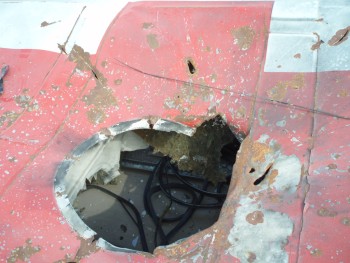There has been a fair amount of discussion, largely on right-wing blogs, of a series of significant instances in which news stories relating to Israel’s conduct of the conflict with Hezbollah and Hamas have been embroidered, staged, or fabricated. The key examples include:
– A purported Israeli missile strike on a marked Reuters car in Gaza, carrying two journalists. The Powerline blog produced evidence which indicates that the car was not, in fact, hit by a missile and suggests that the incident was staged. One of the reporters involved in the story works for Iranian TV.
– Various sequences of photograph, and news footage, illustrate the staging of scenes involving the exhibition of casualities, particularly involving dead children following the bombing of a residential building in Qana. Casualty figures in relation to this incident were also initially reported to be nearly twice as high as they ultimately turned out to be. This story was examined in detail by another right-wing blog: EU Referendum.
– A particularly widly reported incident involved the alleged targeting by Israel of Red Cross ambulances in Lebanon, causing explosions which injured Red Cross workers and those they were transporting. A third right-wing blog – Zombietime – has dissected the photographic evidence in detail and argues, with good cause, that this story was also manufactured, in part or in whole. In particular, a circular hole in the ambulance roof – said to be the entry point of a missile – appears more plausibly to have been caused by the removal of a ventilation port.

This last story is the only one of the three to have produced even a ripple outside the right wing blogosphere. Indeed, the focus of reporting – largely confined to Australia – has been the reaction to the comments of the Australian Foreign Minister, Alexander Downer:
What concerns me greatly is the evidence of dishonesty in the reporting out of Lebanon. For example, a Reuters photographer was forced to resign after doctoring images to exaggerate the impact of Israeli air attacks. There were the widely-reported claims that Israel had bombed deliberately a Red Cross ambulance.
In subsequent weeks, the world has discovered those allegations do not stand up to even the most rudimentary scrutiny. After closer study of the images of the damage to the ambulance, it is beyond serious dispute that this episode has all the makings of a hoax. Yet some of the world’s most prestigious media outlets, including some of those represented here today, ran that story as fact – unchallenged, unquestioned. Similarly, there has been the tendency to report every casualty on the Lebanese side of the conflict as if a civilian casualty, when it was indisputable that a great many of those injured or killed in Israeli offensives were armed Hezbollah combatants.
My point is this: in a grown-up society such as our own, the media cannot expect to get away with parading falsehoods as truths, or ignoring salient facts because they happen to be inconvenient to the line of argument – or narrative – that particular journalists, or media organisations, might choose to adopt on any given controversy or issue.
The Red Cross has rebuked the Australian Foreign Minister for “relying on an unverified internet blog to claim an Israeli missile strike on one of its ambulances in southern Lebanon was a hoax”.
Melanie Phillips may have a reputation for hyperbole: but I do think she makes a fair point here:
In short, much of the most incendiary media coverage of this war seems to have been either staged or fabricated. The big question is why the western media would perpetrate such institutionalised mendacity. Many ancillary reasons come to mind. There is the reliance upon corrupted news and picture agencies which employ Arab propagandists as stringers and cameramen. There is the herd mentality of the media which decides collectively what the story is. There is the journalists’ fear for their personal safety if they report the truth about terrorist outfits. There is the difficulty of discovering the truth from undemocratic regimes and terrorist organisations. There is the language barrier; there is professional laziness; there is the naïve inability to acknowledge the depths of human evil and depravity; there is the moral inversion of the left which believes that western truth-tellers automatically tell lies, while third world liars automatically tell the truth.
But the big answer is that the western media transmit the lies of Hezbollah because they want to believe them. And that’s because the Big Lie these media tell — and have themselves been told — about Israel and its place in history and in the world today has achieved the status of unchallengeable truth. The plain fact is that western journalists were sent to cover the war being waged against Israel from Lebanon as a war being waged by Israel against Lebanon. And that’s because that’s how editors think of the Middle East: that the whole ghastly mess is driven by Israel’s actions, and that therefore it is only Israel’s aggression which is the story to be covered.
There is a widespread assumption on the Medialensish-Left of the internet that news organisations are engaged in an enormous imperialist-capitalist conspiracy to peddle distortions and lies, and to ‘manufacture consent’.
There is, however, complete incredulity that Hezbollah and Hamas might have strong reasons to engage in media manipulation.
That outlook appears to be shared by much of the international press which reported, in a largely unquestioning manner, on these incidents: but which have broadly failed to discuss the significant doubts relating to the truth of events which dominated their headlines.
There will certainly be those who take the view that the only news manipulation worth reporting is that which eminates from the United States and Israel, and that the doubts raised by right wing blog sites should be ignored or – where that is not possible – dismissed in a cursory fashion.
I take a different view. The uncritical approach to news reporting, particularly in the Middle East has resulted in a dangerous potential for degrading of the integrity of news reporting. It has fed off, and into, a sense of hysteria about the conflict.
That is a matter of concern not only for right wing bloggers. It should worry us all.
UPDATE: The Australian stands by the account of the ambulance strike provided by reporter Martin Chulov. But Tim Blair compares and contrasts Chulov’s two accounts of the event, and finds that his story has shifted.


